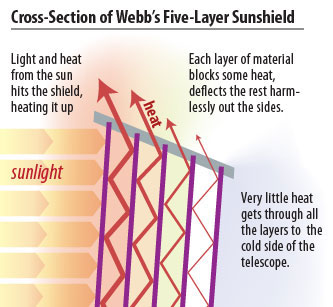JWST Observatory Overview
The JWST Observatory is comprised of the spacecraft bus, the sunshield, the Optical Telescope Element (OTE), and the Integrated Science Instrument Module (ISIM).
On this page
The JWST Observatory is comprised of the spacecraft bus, sun shield, Optical Telescope Element (OTE), and Integrated Science Instrument Module (ISIM), as shown in Figure 1. JWST will orbit the Sun-Earth second Lagrange point.
JWST has 2 distinct thermal regions: the sun-facing 300 K hot side and the 40 K cold side. The spacecraft bus is located on the hot side. The OTE and ISIM are located on the cold side. The hot and cold sides are separated by a sun shield that intercepts over 200,000 W of radiant energy from the Sun and transmits only about 1 W to the OTE and ISIM. By radiating the Sun's energy to space, the sun shield allows the OTE and ISIM to passively cool to cryogenic temperatures, without the use of expendable cryogens.
Spacecraft bus
The JWST spacecraft bus provides electrical power, communications, attitude control, thermal control, health and safety functions, command and data handling, and communications services, as well as propulsion for orbit insertion, orbit maintenance, and momentum unloading. The spacecraft bus is located on the sun-facing side of the observatory and operates in a temperature of about 300 K.
Sun shield
In order for JWST to detect the infrared light from faint objects, the telescope and science instruments must be cooled to ~40 K. This cooling is done passively by a tennis court-sized sun shield; its purpose is to isolate the telescope and science instruments from the energy of the Sun, Earth, Moon, and the JWST spacecraft bus.
The sun shield is a diamond-shaped system of 5 layers of an aluminum-coated polyimide film called kapton. The dimensions of each layer are approximately 21 m long and 14 m wide. Each successive layer of the sun shield is cooler than the one below. The heat radiates out from between the layers, as shown in Figure 2.
Where JWST can point
JWST must maintain an attitude such that the telescope and science instruments are protected by the sun shield from the sun. This basic constraint, combined with the geometry of the sun shield, sets the field of regard, which is the region of the sky where JWST can safely conduct science observations at a given time. The field of regard and when targets are visible will be described in JWST Target Viewing Constraints.

